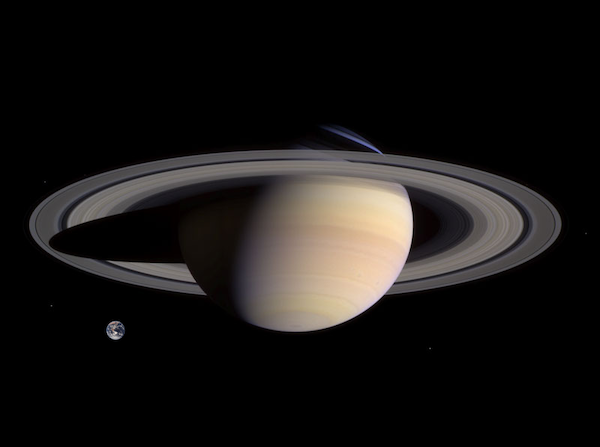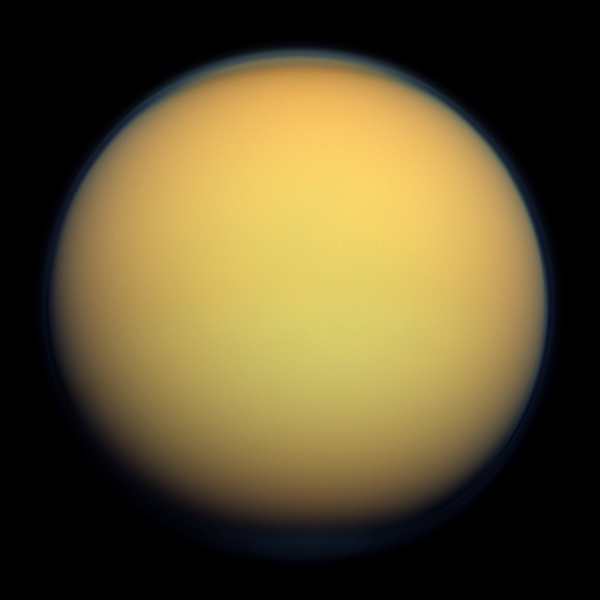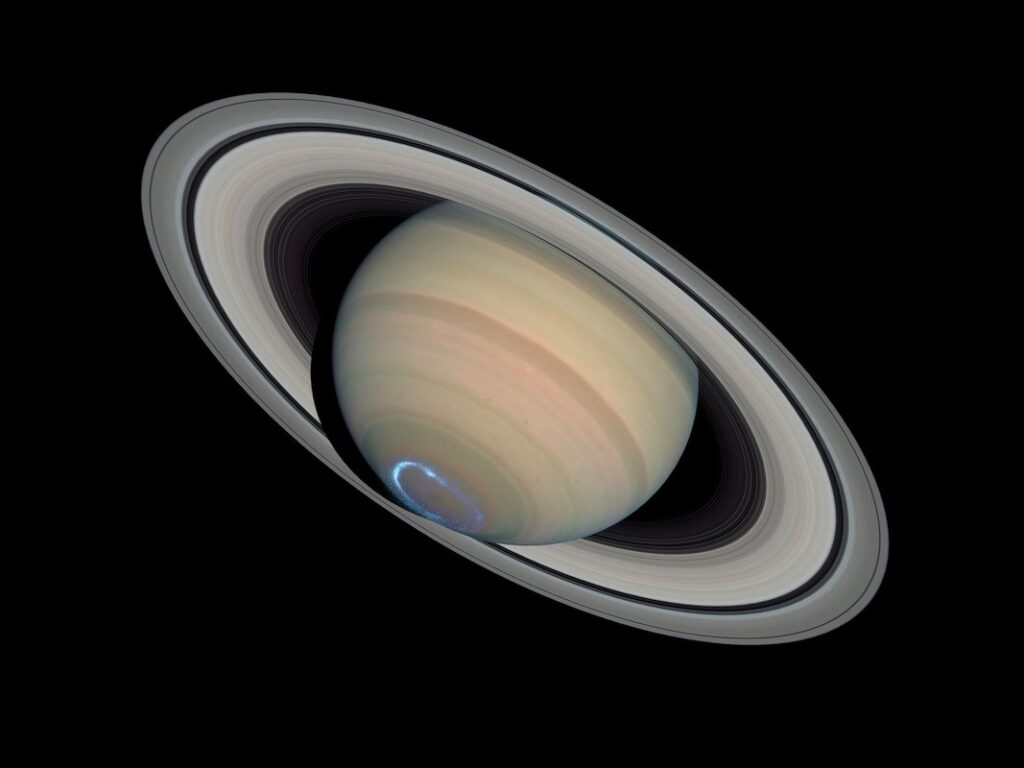Among all the planets you can observe in the sky, Saturn is by far the most spectacular. It is, without a doubt, the rock star of our solar system!
- Saturn in a Few Words
- When Can You See Saturn?
- What Telescope is Best to Observe Saturn?
Saturn was the very first planet we had the chance to observe through a telescope. We can assure you that magical moment – when you place your eye at the eyepiece and see Saturn’s legendary rings – will remain unforgettable, for both children and adults alike.
Saturn in a Few Words
Saturn, the sixth planet of the solar system, is a gas giant that has fascinated astronomers and stargazers for centuries. With its iconic rings, Saturn offers a unique spectacle in the night sky.
Why is Saturn Called Saturn?
Saturn owes its name to the Roman god Saturnus, the god of agriculture and harvests.
The Discovery of Saturn
Although Saturn was visible since antiquity, early observers thought it was just another star. With the invention of the telescope in the 17th century, astronomers were finally able to study Saturn in detail.
- 1610: Galileo Galilei was the first to observe Saturn’s rings, though he misinterpreted them as “handles” or lateral objects.
- 1659: Dutch astronomer Christiaan Huygens correctly identified Saturn as being surrounded by a ring.
Later, in 1675, Jean-Dominique Cassini discovered a gap within the rings – now famously known as the Cassini Division.
Characteristics of Saturn
- Average distance from Sun: ~890 million km
- Length of a day: 10.7 hours
- 1 Saturn year: ~29 Earth years
- Diameter: 114,400 km (second only to Jupiter in size)
- Mass: 95 times that of Earth
- Volume: 843 times that of Earth
- Composition: Mostly hydrogen & helium – classifying Saturn as a gas giant (or a “failed star,” according to some theories)
- Axial tilt: 26.7° → Saturn experiences seasons, and its rings tilt visibly over time from Earth.
The result? A constantly changing and stunning view of Saturn’s rings.

The distance between our planet and Saturn varies between 1.2 and 1.7 billion kilometers. As a result, it takes nearly 80 minutes for sunlight reflected off Saturn to reach Earth. In other words, the image you see of Saturn through your telescope is actually how the planet appeared 80 minutes ago.
Like Jupiter, Saturn is considered a gas giant, composed mainly of hydrogen and helium. Some scientists even suggest that gas giants could be thought of as “failed stars,” since their composition is so similar to stellar matter.
Saturn’s axis of rotation is tilted at 26.7 degrees, which means the planet also experiences seasons—just like Earth. This tilt also causes Saturn’s iconic rings to appear at different angles when viewed from Earth over time, adding even more beauty and uniqueness to its observation.
Of course, the most striking feature of Saturn remains its magnificent rings—a sight that continues to captivate astronomers and beginners alike!
Saturn’s Rings and the Cassini Division
Saturn’s rings are the most complex planetary ring system in our solar system. Composed of countless tiny fragments, made up of about 90% water ice mixed with dust and rock, these rings stretch out to an impressive 282,000 km from the planet. Yet, despite their vast size, they remain surprisingly thin — with an average thickness of less than 15 meters.
One fascinating feature is that each ring orbits Saturn at its own speed, a result of orbital mechanics and Saturn’s immense gravitational influence. This dynamic movement gives the rings a shimmering, almost alive quality when studied over time.
But you can’t talk about Saturn’s rings without mentioning the astronomer Jean-Dominique Cassini. His name may sound familiar thanks to the Cassini–Huygens spacecraft, launched by NASA and ESA in 1997, which studied Saturn and its moons in extraordinary detail.
Back in 1675, Cassini discovered a dark gap between Saturn’s rings—now called the Cassini Division—separating the A and B rings. This gap, about 4,700 kilometers wide, remains one of the most striking features of the ring system and is visible in most amateur telescopes under good conditions.
The Rings in Order
From Saturn outward, the rings are labeled according to the order of their discovery:
- D, C, B Rings
- Cassini Division
- A, F, G, and finally E Rings
Farther out lies the faint Phoebe ring, which orbits at the distance of Saturn’s moon Phoebe and was only discovered with modern instruments.

Primary vs. Faint Rings
- The main rings are A, B, and C, the brightest and best known.
- The fainter rings — D, E, F, and G — were discovered later and require large telescopes or spacecraft observations to be studied in detail.
The exciting part? The Cassini Division itself can be resolved with many amateur telescopes, bringing you face-to-face with the same celestial wonder that Cassini himself first documented over three centuries ago. And if the atmosphere is steady enough, you may even glimpse some of Saturn’s many moons orbiting in harmony with the rings.
The Moons of Saturn
To date, Saturn has 80+ known moons, each with unique features.
- Titan: Saturn’s largest moon (and the 2nd largest in the solar system). It has a dense atmosphere and hydrocarbon lakes.
- Enceladus: Possesses an underground ocean and water geysers.
- Mimas: Known for its enormous Herschel Crater, resembling the Death Star from Star Wars.
Some moons, called shepherd moons, play a vital role in shaping Saturn’s rings.

Titan is particularly fascinating due to its dense atmosphere and the presence of hydrocarbon lakes on its surface.
A little side note: one of our favorite movies, Gattaca, tells the story of a young man whose ultimate dream is to join a space mission aimed at exploring Titan. Here’s a clip where the main character describes what Titan is like.
When Can You See Saturn?
- Saturn is visible to the naked eye, even from cities with strong light pollution.
- It follows the same track across the sky as the Sun and Moon.
- Best viewing: When Saturn is high in the sky, minimizing atmospheric distortion (turbulence, dust, haze).
💡 Tip: Try imagining reading a book through a kettle full of boiling water. That’s exactly how Earth’s atmosphere distorts your view of Saturn from low on the horizon!
What Telescope is Best to Observe Saturn?
You don’t need a professional telescope to enjoy Saturn. Here are the key factors:
🔭 1. Aperture
Our advice: The planet can be observed with a small telescope, starting from an 80 mm aperture. However, to see details on Saturn’s surface and its rings, it’s recommended to opt for a telescope with at least a 100 mm diameter.
- 80 mm: Saturn appears as an oval spot, rings not clearly distinguished.
- 100 mm: Rings visible, plus some moons.
- 200 mm: Rings and several moons appear clearly.
- 254 mm: Cassini Division visible + subtle surface color variations.
🔭 2. Eyepieces
- Standard kits include a 25 mm & 10 mm eyepiece, plus a 2x Barlow.
- The 10 mm eyepiece is great for observing planets like Saturn.
- Advanced users can upgrade to 9 mm or 7 mm eyepieces for extra detail (within the telescope’s maximum magnification).
🔭 3. Mount Types
If you’re not sure what we’re talking about here, we recommend checking out our guide on choosing a telescope for kids and beginner stargazers. But to put it simply, there are three main types of mounts: the alt-azimuth mount, the equatorial mount, and the Dobsonian mount.
Equatorial mounts (EQ): more complex, ideal for astrophotography (requires polar alignment).
Alt-azimuth or Dobsonian mounts: best for beginners.
So, Which Telescopes Should You Choose?
🔭 The Maksutov Telescope – An Excellent Choice for Planetary Observation
Maksutov telescopes deliver powerful magnification thanks to their design, which uses a series of mirrors that make light travel a path nearly three times longer within the optical tube. Combined with the lens at the front of the tube and a 10 mm eyepiece, this design allows you to observe Saturn in all its glory—its iconic rings and even the Cassini Division.
Advantages:
- Comfortable and easy to use, simple to transport.
- Can be used in urban areas without being significantly affected by light pollution.
- Ideal for planetary observation, making it a great choice for beginners.
Disadvantages:
- Better suited for planetary observation than for deep-sky objects. Its main strength is its strong magnification, but it isn’t the optimal instrument for galaxies or nebulae.
- Price can be relatively high, especially if your focus is purely planetary observation.
🔭 Skywatcher Dobson 150/1200 Skyliner Classic – A Complete Newtonian Telescope
The Skywatcher Dobson 150/1200 Skyliner Classic is one of the most popular instruments on the market and is perfectly suited for deep-sky observation. While it shines in dark, rural skies, it can be more challenging to use in urban environments due to light pollution.
👉 You can find a full review of this Dobsonian telescope in our guide to beginner and teen telescopes.
Main Qualities:
- Its versatility is its greatest strength: with a long focal length and large aperture, this Newtonian is excellent for both planetary and deep-sky observation.
- Its price is another major advantage. When paired with a Dobsonian mount, the cost remains affordable compared to refractors, since mirrors are generally cheaper to manufacture than lenses of equivalent size. The larger the aperture, the more value you get.
- Perfectly suited for beginners living in rural areas.
Disadvantages:
- The Newtonian telescope is bulky and heavy. If you want to stargaze away from home, you’ll likely need a car to transport it.
- Performs best under dark skies, where light pollution is minimal.
➡️ For budding amateur astronomers, a Newtonian on a Dobsonian mount is one of the best options to start with.
🔭 The Refractor Telescope – A Simple Choice for Observing Saturn
If your only goal is to observe planets and you want a straightforward, user-friendly instrument, a refractor telescope may be the best choice. Refractors are:
Advantages:
- Affordable compared to other telescope designs.
- Can be used in urban areas.
- Lightweight and portable—easy to take anywhere.
Disadvantages:
- More suited to planetary observation than deep-sky. With a suitable eyepiece, you can still view certain nebulae or clusters, but it’s not its strength.
- At very high magnifications, chromatic aberrations can appear, creating slight image blurring and color fringing.
For Saturn and its stunning rings, a 90/1000 refractor from Skywatcher or Celestron is an excellent option (priced between €200 and €300). In our comparison of telescopes for kids over 10, we particularly recommend the Omegon AC 90/1000 EQ-2 refractor, which is perfect for planetary viewing while also offering some capabilities for deep-sky observation.
Saturn Awaits!
Now that you have the right information, you can confidently choose the best telescope to admire Saturn. As you’ve seen, finding the ideal instrument for planetary observation—and especially for viewing Saturn’s breathtaking rings and the Cassini Division—depends on several factors:
- Your location:
- Urban observers → A refractor telescope or Maksutov is the best option.
- Rural observers → A wider range of instruments is possible, from refractors to Dobsonians, depending on budget.
- Your budget and goals:
- A €200 refractor won’t compete with a €400 Maksutov in terms of detail, but it will still be more than enough to enjoy Saturn and lunar craters.
- Your motivation:
- More powerful telescopes (like Newtonians with equatorial mounts) require learning processes such as polar alignment. While this can discourage casual observers, the reward in terms of image quality is tremendous.
✨ We sincerely hope this guide has helped you select the right telescope to observe Saturn and its magnificent rings.
And if you’re looking for a fun way to introduce children to the magic of space, check out our star light projectors guide!

Pingback: 30 curiosités à savoir sur la Lune